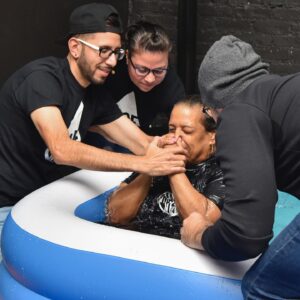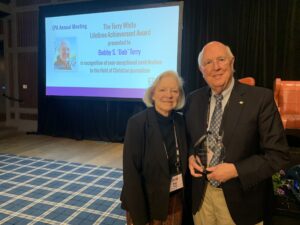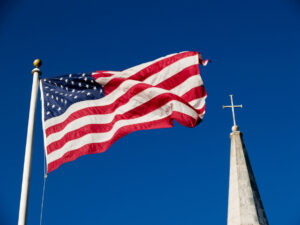
GREENSBORO, N.C. (BP)–Messengers to the Southern Baptist Convention June 14 declined to get involved in a complex and messy legal battle between a small California church and an association.
Michael Stewart, director of missions for the Central Coast Baptist Association (CCBA) in Gilroy, Calif., made a motion the day before concerning the denominational affiliation of New Life Community Church of Prunedale, Calif. Specifically, Stewart’s motion asked messengers to instruct the SBC president to write a letter “retracting” a 2005 letter from an Executive Committee employee that had welcomed New Life into the SBC.
New Life reportedly voted to become an SBC church in 2005 and has given directly to the SBC allocation budget two years in a row. But the church is at the center of a lawsuit in California over whether it took control of another SBC church’s property. Each side in the issue has given conflicting facts and testimonies.
After a short debate June 14, messengers affirmed the recommendation from the SBC Committee on Order of Business in ruling Stewart’s motion out of order. Roughly two-thirds of messengers voted in a show of ballots not to overturn the recommendation. SBC President Bobby Welch said he participated in the meeting of the committee.
“We did carefully move through this,” Welch told messengers. “… [A]ll that has transpired in there [the meeting] is fairly involved -– not to say confusing -– but fairly involved.”
On June 13 Stewart also challenged the seating of messengers of New Life Community Church. But the church sent no messengers.
The controversy over New Life began in 2004, when Stewart and the CCBA brought a lawsuit against two churches — New Life Community Church and First Baptist Church of Las Lomas, Calif. — seeking to acquire the property of FBC Las Lomas. Stewart and the CCBA argue that New Life was trying to take over the property of FBC Las Lomas, which had approximately 10 members, mostly elderly. They also say FBC Las Lomas had ceased to be an SBC church –- a claim, which, if true, would have triggered a clause in the church’s constitution reverting the property back to the association.
But several FBC Las Lomas members say they never ceased to be an SBC church, and that instead of it being a “takeover,” New Life was welcomed with open arms. The goal, these members say, was to keep their tiny church from dying, to bring more people into the building and to keep its founder’s wishes alive — that is, that the church never close. The two churches meet together on Sunday mornings and Wednesday nights, under one roof at the same time, with the same pastor, Hank Holley — although they have different budgets, FBC Las Lomas member Bonnie Caudill, the church treasurer, told Baptist Press.
These FBC Las Lomas members consider Stewart’s action a violation of their church autonomy.
New Life Community Church was a nondenominational church in 2004 with about 40 members, but had no building and had been meeting in a senior center. The FBC Las Lomas church building seats around 100 people, one member told Baptist Press. FBC Las Lomas was founded in the 1960s.
The May 2005 letter welcoming New Life Community Church into the SBC was from John Revell, editor of SBC Life and a director in the office of convention relations with the SBC Executive Committee –- without knowledge that there was an ongoing lawsuit and that the letter could be used in a court battle, he said.
Revell said the letter was a fraternal greeting he sent after the EC business and finance office informed him that a contribution had been received. He said the letter indicated the church had complied with the constitutional requirements.
Revell told Baptist Press that he “explained to Holley that the EC did not issue ‘official letters’” after Holley had requested one, but that the letter was sent as confirmation of receipt of the church’s contribution.
Both Stewart and Allan Blume, chairman of the Committee on Order of Business, spoke to messengers June 14.
“Affiliation with the Southern Baptist Convention is determined under Article III of the SBC Constitution –- not by a letter from the Executive Committee,” Blume said. “Article III requires only a contribution to the convention’s work and that the church be in friendly cooperation with the convention and sympathetic with its purposes and word. The convention has historically presumed that churches which vote to be affiliated with the Southern Baptist Convention and contribute to its work are in friendly cooperation.”
The convention has, Blume said, “on occasion” determined that contributing churches are not in friendly cooperation. One such instance, he noted, occurred in the 1990s when the SBC disaffiliated two churches that affirmed homosexuality.
“However, that action was taken only after a review of the facts by the convention’s Executive Committee and upon its recommendation to the convention,” Blume said. “In the present motion there has been no investigation of the facts by the Executive Committee or by any other body. There are facts in dispute, and there is no one here from the New Life Community Church to represent the church’s side. The committee is of the opinion as a matter of fundamental fairness and integrity that under these circumstances, the convention cannot find a church which has voted to affiliate with the Southern Baptist Convention and contributed to the convention’s work is not … in friendly cooperation with the convention and sympathetic to its purposes and work.
“In absence of any opportunity or means for this convention to determine the facts regarding the church,” Blume said, the motion should be ruled out of order.
Stewart urged messengers to overturn the ruling of the chair and allow the motion to be debated on the floor.
“My association of 105 churches in California agreed together that the issues we were dealing with were very serious with a non-SBC church taking over an SBC property,” he said. “… We were engaged in that for two years. My association voted for me to come here after we had dealt for six weeks with the employees of the SBC Executive Committee, who determined that the letter that they sent could only be undone by the messengers of this convention. … I simply want to state the case and for the Southern Baptist Convention -– these churches -– to make the determination as to how we’re going to operate and cooperate as associations, state conventions and the national entities.”
Stewart and the CCBA won the lawsuit last October, when a California state judge ruled that FBC Las Lomas had “ceased to function as a Southern Baptist Church” and that the property belongs to the association. But FBC Las Lomas is planning on appealing.
Among the allegations and counter-allegations between Stewart and FBC Las Lomas church members:
— Stewart points to a March 2004 FBC Las Lomas business meeting, in which he says a majority of church members gladly signed a legal document dissolving the church and giving the association the property. But several church members say they felt misled into signing the document, which they say they thought would have allowed Las Lomas to keep its property. They say their attorney wasn’t present at the business meeting and that they subsequently signed a document rescinding their earlier action. Stewart denies the charge that he pressured the members — he says it was purely voluntary — and he also says the church had no attorney at the time.
— Several FBC Las Lomas members say they believe that the association’s interest in the property is strictly financial. The property — located in a high-priced area of northern-central California — is worth more than $3 million and has two rental properties (both homes) on site. Stewart denies that and says the property would be used to start a Spanish-speaking church.
— In the lawsuit, Stewart and the CCBA argued that FBC Las Lomas had ceased to be a Southern Baptist church, thereby triggering a clause in the church’s constitution reverting the property back to the association. But the church members say they never ceased to be Southern Baptist and had no intention to do so.
— In the lawsuit, Stewart and the CCBA alleged that the two churches — FBC Las Lomas and New Life — had agreed to a “memorandum of understanding,” in which the assets of FBC Las Lomas would transfer to New Life Community Church. But several church members say that the memorandum was never signed, and that even if it had, it wouldn’t have given the property to New Life.
— Some people knowledgeable with the situation say that Stewart opposes the 2000 Baptist Faith and Message and voted against it becoming the association’s statement of faith. However, the association has a summary of the BF&M posted on its website. Notably absent, though, is any mention of the articles on female pastors and biblical submission in the husband-wife relationship. In an interview with Baptist Press Stewart declined to discuss his position on the BF&M.
“It has taken a toll on all of us,” Caudill, 80, said. “[Stewart] keeps saying that Hank and his group were trying to take over. But all we asked them to do was come over and join us and fellowship with us.”
Holley receives no salary from FBC Las Lomas, she said, and is considered to be a voluntary pastor for FBC and a paid pastor for New Life Community Church.
“Throughout this process my goal, and the goal of NLCC and FBCLL, has been to grow an effective, vibrant Southern Baptist church to the glory of God,” Holley said.
Holley planted New Life Community Church in the summer of 2003 as a nondenominational church. Early the next year, they were approached by members of FBC Las Lomas, which had to let their pastor, Jack Johnson, go due to a lack of finances, Caudill said.
“We invited them over to share [our building],” FBC member and trustee Luther Burbank, 81, said. “We couldn’t have a pastor [because of finances]. There were only about six or eight of us in the church.”
Caudill says she recalls telling a friend, who was a member of New Life Community Church, “Do you think your group would like coming over and joining us –- worshiping with us? We need people and a pastor. You need a place to meet.”
But Stewart paints a different picture and says the FBC church constitution wasn’t followed “in firing” the pastor. He also says the church had “around $25,000” in the bank when it let its pastor go and that FBC Las Lomas has “merged” into New Life. Caudill says the money came from cashing in a CD.
“The concept that they were out of money is not factual,” he said, adding that FBC’s money was used for legal fees.
Stewart sent out a series of e-mails to SBC directors of missions, explaining his side of the story and urging the DOMs to show up at the SBC annual meeting and support his motion.
“What would you do, as a Director of Missions, if a pastor and a trustee from an associational church came to your office and reported that a non-denominational church was secretly conspiring with another trustee to take control of the church and its assets?” Stewart wrote. “That happened here in January of 2004, when the leaders of the Las Lomas Baptist Church appealed to the Central Coast Baptist Association for help.”
Those leaders were the former pastor of FBC Las Lomas and his family, who were still members.
“We asked [Holley] not to seize the property,” Stewart wrote. “But on Mother’s Day 2004, he did just that and we were forced to ask the courts to rule on the lawful ownership of the property.”
Stewart told BP, “These are difficult situations, and our executive board of our association is unified on this decision that we made two years to keep our word to the founders and the mother church and the pastors involved in this whole affair.”
In his ruling, the California state judge pointed to the FBC Las Lomas constitution, which states that the pastor “shall lead the church in cooperating with the work of its local association and the state and national conventions of Southern Baptists.” It also says that the church’s assets — should the church “cease to be a Southern Baptist Church” — “shall be given” to the Central Coast Baptist Association. The judge said there was “uncontroverted evidence” that FBCLL had ceased to be Southern Baptist, pointing to the vote the members had taken to dissolve — the judge didn’t recognize any actions revising that vote — and the fact that it fired a “Southern Baptist pastor” and hired one who “is not a Southern Baptist.” The judge also said the memorandum of understanding would have transferred all of FBC’s assets to New Life Community Church.
Caudill, though, said the church never had plans to leave the SBC.
“We are not governed by the association,” she said. “Our constitution clearly states that we are an independent church. We belong to a Southern Baptist association, but … we are self-governed.”
Holley said New Life Community Church’s members voted in May 2005 to affiliate with the SBC.
“We were not interested in obtaining property but only in helping this struggling church survive as its founder and members wished,” he said.
Asked prior to the annual meeting why New Life Community shouldn’t be considered a Southern Baptist church when it voted to become an SBC church and gives to the SBC budget, Stewart said, “I would say that would be a question the messengers will get to decide. In our structure, you normally have to join when you’re in friendly cooperation and sympathetic to the causes of Southern Baptists.”
Larry Lewis, former president of the then-Home Mission Board, testified on behalf of FBC Las Lomas and New Life Community Church during the trial.
Caudill said she wants to see the convention look at the issue closely.
“Hopefully we can hang on to this little church,” Caudill said.
–30–















